The transition from Netzwerk Energie & Umwelt (NEU) e.V. to EnergieNetzWerk Mitteldeutschland e.V.
2024/08
As a member of the board, Quantensprung has accompanied the association's transformation. From our point of view, EnergieNetzWerk is a great example of a successful transformation process and makes it clear what it takes to make change a success: it starts in the mind with the creation of a clear vision, the involvement of all stakeholders, and, most importantly, perseverance.
Background and motivation for change
Since 2011, the Leipzig-based association known as “Netzwerk Energie- und Umwelt e.V.” (Energy and Environment Network) has been working to connect regional businesses, science, and administration. The association was formed by a group of local entrepreneurs who, together with the City of Leipzig's economic development agency, recognized the need to bring together municipal interests with the regional economy and science in a cluster. The aim was to create a network that facilitates knowledge transfer, initiates projects, and promotes synergies that benefit all participants.
From the outset, the association was closely linked to the city of Leipzig and its energy and environmental technology cluster, which operated under the brand name “ENERGIEMETROPOLE LEIPZIG.” This connection made it possible to coordinate and promote activities along the entire value chain of the region. In the early years, many ideas and initiatives came from the city's economic development agency, which provided significant support for the establishment and further development of the network.
However, with increasing complexity and a broader spectrum of regional economic challenges, companies and scientific institutions themselves have increasingly come to the fore in recent years in order to independently advance topics and project approaches. At the same time, pressure from national and European competition is intensifying, making even closer cooperation between regional players necessary.
In order to better meet these changing requirements, a new board structure was introduced in 2021. Long-time chairman Kai-Uwe Blechschmidt, who has been in office since 2016 and works for the municipal L-Group, remained in office. Angelika Bordt joined as deputy chairwoman and Daniel Landgraf as treasurer. At that time, management consultant Angelika Bordt was leading a Smart Infrastructure Hub project to establish a regional research network in the fields of energy and the environment, among others, and contributed her research network and expertise in science transfer. As a successful entrepreneur in the energy industry, Daniel Landgraf brings an important industry perspective to the board.

There had been changes in the board before. But what led to this fundamental change?
The association had one permanent position for the office manager. All other tasks of the board and the cluster team leaders were and are performed on a voluntary basis. The association is mainly financed by cluster funding from the city of Leipzig, membership fees, and project funding. All in all, this is just enough to finance the permanent position. This means that there are no resources available for growth, and “too big to die, too small to grow” became a problem.
The new board therefore fundamentally questioned the association's raison d'être and analyzed the structure of services offered throughout central Germany. The result confirmed that the association had great potential for the energy sector, as there was no network offering for energy topics other than hydrogen, apart from Energy Saxony e.V., which primarily serves the Dresden region and omits many topics that are important to us. This made the association's growth target its guiding star.
The path to a new vision
Step 1: The mindset of the board
First, the board had to overcome its own reservations and agree on the objectives. The association was finding it increasingly difficult to fill the clusters with content, as there was ultimately only one cluster team leader left who was working on his topic. The initial position of the board was that it was the association's task to provide the framework conditions, but that members had to use them on their own initiative. Since this hardly ever happened, it was assumed that the members did not want to participate actively and that the opportunity to attend specialist events was sufficient. The difficulty of finding suitable project partners for project ideas seemed to confirm this. This was justified by the existing membership structure, which consisted largely of micro-enterprises or self-employed persons.
The new board agreed that supply and demand needed to be examined and that the association might need to become more attractive to other member groups. In this process, it was important to them to take their current members with them and not lose any. Therefore, in January 2023, the board initiated the first member workshop on the reorientation of the association.
Step 2: Member workshops
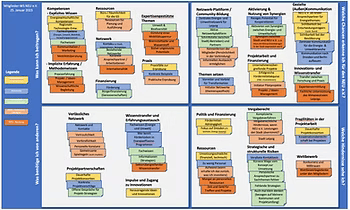
For the first member workshop in January 2023, association members were invited to think about why they are members, where we are headed as a network, and what we want to achieve. Over half of the members actively participated. The workshop explored what each member company can contribute to the association, what they need from others, and where they see opportunities and obstacles. The results were clustered according to the groups: municipal companies, municipalities, associations/cooperatives, consulting SMEs, and SMEs for technical solutions. The wealth of possibilities thus became not only tangible but also visible. As a result, the association not only activated its members, but also decided on the new format of the idea workshops and paved the way for regional expansion into central Germany. In addition, it became clear that the “Energiemetropole Leipzig” brand no longer fits the network's goals.
The workshops were continued on a quarterly basis as idea workshops in order to translate the new impulses into results. In the idea workshops, members can contribute their own project ideas and recruit like-minded people. If several interested parties come together, this forms the basis for a new working group with the aim of designing a project. At the first ideas workshop, hosted by our member Cenero, nine project ideas were discussed, three of which were pursued further.
In addition to knowledge transfer, the external formats are also increasingly focused on activation and active networking
Step 3: General meeting decides on new association structure
A year later, in January 2024, as a consequence of the changes, the board presents a proposal to restructure the association, which is unanimously approved. The association thus bids farewell to rigid cluster teams and opts for solution-oriented working groups. The advantage lies in the focus on current problems and joint solution finding. A working group only has a right to exist if it describes a specific problem for which the industry needs a solution. Once the problem has been solved, e.g., through a specific project, or is no longer relevant, the group is dissolved. This flexible organization also allows for better interaction with other industry networks.
The working group organization emerged from idea workshops. From now on, members are encouraged to promote new working groups at association meetings or to get involved in them. The board and office are encouraged not only to think more broadly in regional terms, but also to take greater account of the target groups of large companies and local authorities.

In addition, it was decided to part with the old name and to make the new regional orientation visible in the name as well. The board was tasked with finding a new name. The new name will be unanimously decided at the next meeting in August 2024.
In addition, the board began taking the first steps toward digitizing the association with the introduction of the WISO association software, with the aim of reducing the workload of the office management and board work and freeing up resources. WISO enables both systematic CRM and digital accounting.
Step 4: Reformulation of the association's vision, mission, and values
Based on the results of the members' and board's work, the board formulates the association's new self-image:
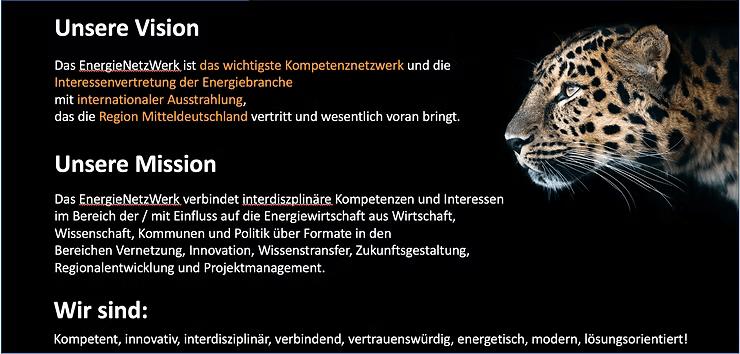
Our vision (Where are we headed?):
The Energy Network is the most important competence network and interest group in the energy sector with international reach, representing and significantly advancing the region of Central Germany.
Our mission (How do we get there?):
The Energy Network connects interdisciplinary expertise and interests in the field of or with influence on the energy industry from business, science, local authorities, and politics through formats in the areas of networking, innovation, knowledge transfer, shaping the future, regional development, and project management.
We see ourselves and want to be perceived as:
Competent, innovative, interdisciplinary, connecting, trustworthy, energetic, modern, solution-oriented!
Step 5: The internal change becomes visible to the outside world
At the summer party in August 2024, the board presents two new anchor points that also manifest the reorientation of the association to the outside world:
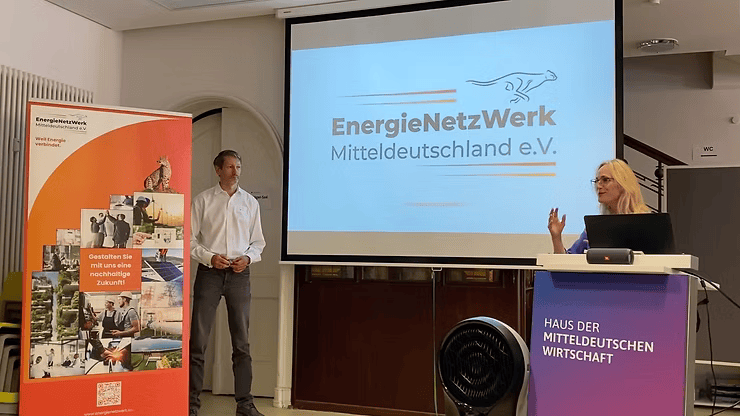
- New location in the Haus der Mitteldeutschen Wirtschaft
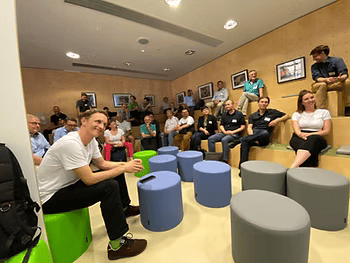
The House of Central German Economy brings together the management teams of Central German industry clusters in a co-working space. The association sees this as an opportunity to create synergies and achieve concrete results through the direct exchange of information.
2. Brand relaunch
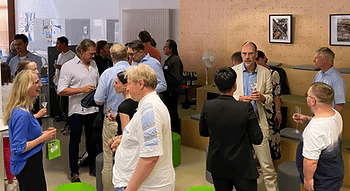
The Netzwerk Energie- und Umwelt e.V. (Energy and Environment Network) is not only getting a new name, EnergieNetzWerk Mitteldeutschland e.V., but also a completely new look in line with its new identity. The development of a new brand is preceded by a thorough analysis process. Each element has strategic significance and affects the mindset and operational activities.
Step 6: The working groups
The following working groups (WG) are starting their work at the House of Central German Business:
- Aquathermal energy
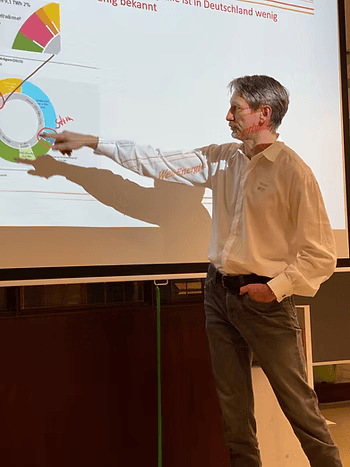
The Aquathermal Energy WG aims to increase the importance of water for generating environmental heat. To this end, the working group will share expertise on technical solutions and push for the development of a technology demonstrator. This is linked in particular to questions regarding approval procedures and existing information bases in order to provide authorities, developers, and investors with the necessary decision-making aids.
2. Heat from cold / cold from heat
The working group aims to raise awareness of the possibilities and opportunities among a wide range of stakeholders in the region by imparting knowledge in an objective manner. To this end, experiences will first be exchanged and concepts or the latest product approaches will be presented and discussed. The aim is to create a heat transformation in both directions. In addition to thermal cooling based on waste heat, the innovative use of suitable low-temperature sources through thermally or electrically driven heat pumps will also be a topic of discussion.
3. Photovoltaics
Currently in the initiation phase.
4. Citizen energy cooperatives
Currently in the initiation phase and will focus on models and needs in rural areas.
5. Securing skilled workers
The AK Fachkräftesicherung (Securing Skilled Workers) working group is working on national and international solutions to combat the shortage of skilled workers in the technical sector. This includes concrete measures on the ground to improve STEM education, training and further education measures, as well as employer branding and recruitment measures, intercultural skilled worker and trainee acquisition, and international university cooperation.
6. Political influence
The “Political Influence” working group plays a central role in representing the political interests of the Central German energy industry. Through targeted lobbying, public communication, and the establishment of networks and collaborations, it contributes to shaping the political framework in the interests of the industry. The working group serves to lay the foundations on which the association can become a politically effective voice for the energy industry.
The change process is not yet complete. On the contrary, the spirit of questioning, experimentation, and improvement has become part of the association's DNA and is being enshrined in the new processes.
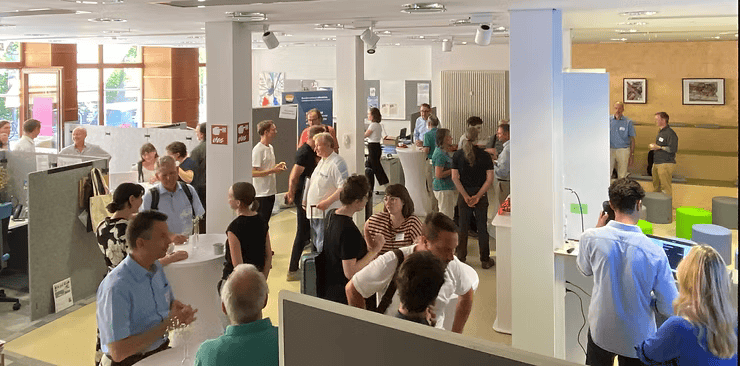
What lies behind the new brand
A new brand initially means a new corporate identity, a new website, and a new social media presence. Behind this lies a new communication strategy, both internally (for and with members) and externally (strategic press and public relations), a new target group-oriented sales strategy, and changes in the team and organization. The team is expanding to include a dual student in the area of marketing and communication. Work and communication processes have been and are being optimized to meet the new requirements, digitized where appropriate, and formulated and documented in a way that will facilitate handover and training in the future.
The name
EnergieNetzWerk Mitteldeutschland contains the following meaningful elements:
- Energy: the focus on an overarching theme that is understood by everyone.
- Netzwerk: our core, what we are.
- Werk: stands for “working on it” and a focus on results and solutions.
- Mitteldeutschland: the regional focus.
The slogan
The core messages of the slogans accompany our public image and are intended to sum up who we are and what we do:
Because energy connects.
Join us in shaping a sustainable future.
The colors
The colors orange, yellow, white, and black represent strength, innovation, curiosity, competence, and clarity, and have an energizing effect.
The font
Montserrat is a modern, charismatic sans serif font with a distinctive x-height/mid-length. It is characterized by its geometric simplicity and significantly helps to draw the reader's attention.
Our brand symbol or brand mascot
The cheetah as a power animal symbolizes uniqueness, speed, and grace:
- It is unique because it is neither a big cat nor a small cat. Just as the energy network does not represent a single region, but is also not a nationwide association.
- It has to make quick decisions and thus serves as an aid in quickly achieving set goals.
- The cheetah symbolizes dignity, recognition, and appreciation because it is known as a prudent hunter. A cheetah's coat is a testament to invisibility. Just as invisible to others, the symbol bearer can achieve its goals more quickly.
- Perseverance is another characteristic of the cheetah, which uses and directs energy in a targeted manner.
- The cheetah is extremely precise in its actions. It thus stands for a pronounced goal orientation.
- With these characteristics, the cheetah as a leading figure underpins the identity and action orientation of the Energy Network.
The logo

The logo combines these elements to convey speed, action, and movement. It clearly reflects the board's drive to move away from stagnation and toward development and growth.
The structure of the homepage
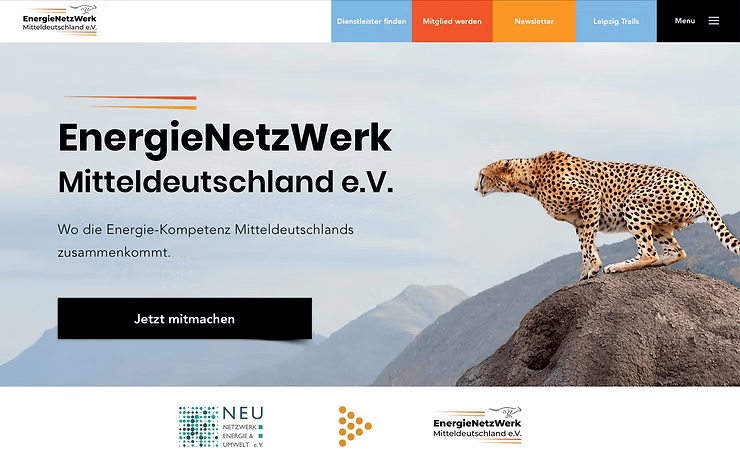
www.energienetzwerk.eu
The content of the new homepage is strongly geared towards activation. The visitor should understand what the network stands for, who is behind it and what he or she can do or achieve in or with the network. The primary goal of the association is for visitors to sign up for the newsletter, attend events and get involved in the working groups. The secondary goal is membership. The menu navigation therefore focuses on the areas “About us”, “What we are working on”, ‘News’ and “Meet-ups”. The goals are to be achieved not only through the content in these areas, but also through the presentation of one's own expertise by imparting relevant knowledge in the subject areas and through personal proximity and contactability.
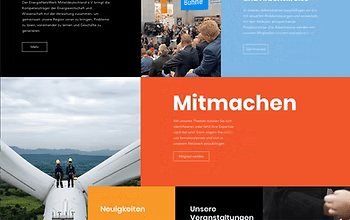
The presentation of members is subdivided into companies, science and municipalities. This makes the results of new member recruitment transparent for the association itself.
The “Find service providers” page is currently under construction. In future, we want to systematically show which problems our members can solve for which target groups.
At present, the framework has been developed and is now gradually being improved with relevant content.
Hidden behind all the buttons are digital processes that make workflows in the office easier. Starting with automated responses, reminder functions for events, integrated payment processes through to digital membership applications. Linking options with the CRM from the accounting department are currently being examined in order to eliminate manual sources of error here too.
And now?
What you can expect next from EnergieNetzWerk
- Expansion of the working groups and development of specific projects and new formats from them.
- Finding solution-oriented service providers.
- More presence in social media, especially LinkedIn, Instagram and Facebook.
- On-site events at member companies.
- Expansion of the Leipzig Trails, a visitor format for knowledge transfer for external delegations.
- More own contributions and statements on current legislation.
- A revision of membership models based on turnover rather than number of employees and a new membership model for start-ups.
- New formats for innovation transfer and market ramp-up support between science, start-ups and industry.
- The next expert meeting with a new look and feel!
- Expansion of EnergieNetzWerk to become the voice of the energy industry in Central Germany.
How you can get actively involved in EnergieNetzWerk
- Represent your interests as a participant in one of the existing working groups.
-
Organize your own working group and bring together the interest groups you need to find a solution.
-
Use the association structure to present yourself and your topics via the various event formats.
-
Do you see further needs and do your ideas go beyond ours? Bring them in via the network meetings or the office!
-
Help shape the association as a whole and enrich our board!
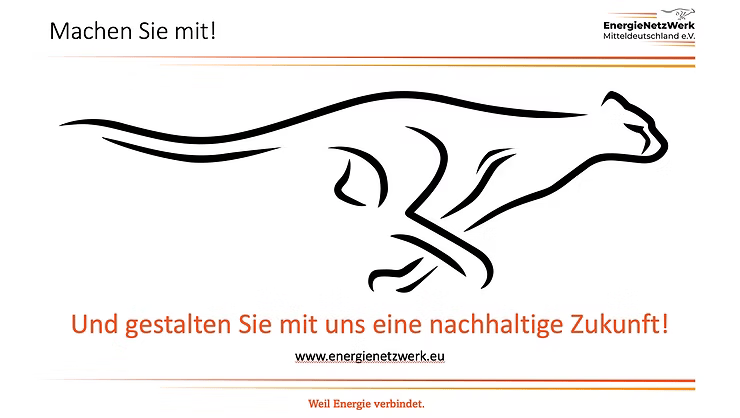
Have we inspired you to make your own quantum leap?
Make your story a success with us!

Suggested post
Business succession is an exciting and complex project in which every purchase and sale is unique. Even experienced buyers who have already acquired over 100 companies in the same industry emphasize that each transaction must be tailored individually.
Together with the Saxony State Association of Economic Council, Quantensprung travelled to Warsaw to explore the possibilities of cross-border collaboration. Meetings with local business leaders and institutional partners focused on innovation, skilled labor exchange, and strengthening economic ties between Germany and Poland.
The fact that benchmarking can be more than an analytical exchange of knowledge is proven by the merger of currently 10 tax consulting firms from northern and central Germany. What began in 2003 as an exchange among colleagues initially developed into a "tax specialist" circle and manifested itself in 2020 with the founding of a cooperative under Consulista eG. In November 2024, we were able to welcome the law firm owners to their owners' meeting at Quantensprung in Leipzig.

Comments